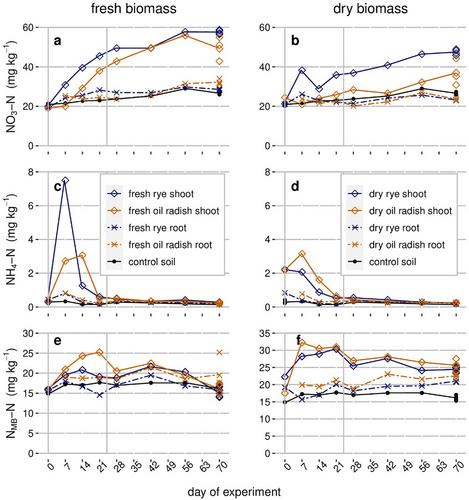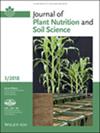Nitrogen transformation as affected by decomposition of 15N-labeled cover crop shoots and roots
Abstract
Background
Incorporation of cover crop (cc) shoot and root biomass can have different effects on nitrogen (N) dynamics and the transformation of soil-derived N and cc N.
Aims
The objective was to determine the effects of different ccs, cc compartments (roots and shoots), and pretreatment of cc biomass (fresh vs. dried) on mineralization processes and on the transformation of soil and cc N following incorporation into a silty loam soil.
Methods
Soil columns with incorporated 15N-labeled root and shoot biomass of two cc species (winter rye and oil radish) and different pretreatments (dried and fresh) were incubated for 70 days at a constant temperature and soil moisture (8°C, 40% water-filled pore space). Carbon and N transformation dynamics were determined repeatedly, distinguishing between N originating from cc biomass and from soil.
Results
Net CO2 emission was related to the amount of soluble cell components added with ccs. Net N mineralization was negatively related to the C:N ratio of cc biomass. The incorporation of dried cc biomass caused higher initial soil respiration and N immobilization than fresh biomass. All treatments with cc incorporation showed increased N2O emission. Emitted N2O-N consisted mainly of cc N (55%–57%) in treatments with fresh shoot biomass, whereas soil N was the main source of N2O (75%) in the treatment with fresh oil radish roots. Recovery of cc 15N was affected by crop compartment and pretreatment. At the end of the incubation, it was 17.5%–42.3% in soil NO3−, 0.1%–8.1% in microbial biomass N, and less than 0.23% of cc N was found in cumulative N2O emission.
Conclusion
The incorporation of cc roots and shoots had different effects on N mobilization and immobilization processes and on the partitioning of cc N. These processes can be influenced significantly by pretreatment of the added plant biomass (dried vs. fresh).


 求助内容:
求助内容: 应助结果提醒方式:
应助结果提醒方式:


